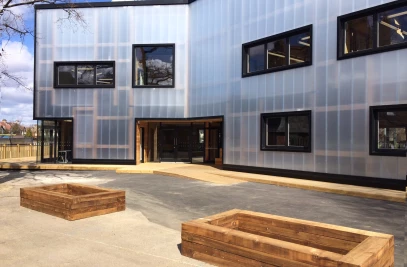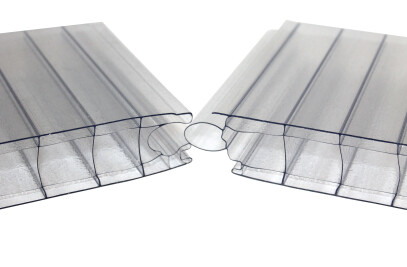The new school sports hall in Zlatar Bistrica was designed to make up for the needs of the local community and sport clubs lost to the fire that swallowed the old building. It reflects the community's ambition to transcend its own local limits by hosting big events through sports. The idea is to catalyse social, recreational, and sporting life, bring the community together, and increase local quality of life. With its large spans it relies on staple large warehouse design using prefab elements, which have been customised for this particular purpose.

Prefab concrete also dominates the façade walls and consists of three layers: dolomite aggregate diabase with finishes on both sides and isolation in the middle. With its dark green hues the finishes remind of the local building tradition using greenstone mount Medvednica slate in particular, which is no longer available. As the terrain slopes westwards, the interior reflects its spatial continuity between the gallery, which is at the level of the school square, downward to the sport courts, which are at the level of the southern entrance. The interior is defined by laminated wooden beams and secondary structure, and wood has consistently been used as acoustic and equipment material, such as grandstand benches and wall panels around the interior court. The western façade is distinguished by slanted concrete panels that let light in but prevent the glare of the setting sun.

NOP Studio: Zlatar Bistrica Sports Hall
Relevance and empathy for everyday urban life
Maroje Mrduljaš

Sports hall: an important social function
Community sports halls are a somewhat marginalised building type, even though they provide programmes central to local communities and have a specific, rather noble social function. They belong to buildings with largest interiors fit for public gatherings such as fairs, concerts, and, of course, sporting events. They often make part of school building complexes and become functional and symbolic centres of small communities with limited public architecture. Designing a sports hall is therefore an important urban challenge, as it has to resolve the basic contrast between a simple hall and an important public building. This contrast is a common pitfall for investors and designers alike. While the functional requirements for a sports hall can be met with a basic, even prosaic design, such design may miss the opportunity for a large investment such as this to also make a cultural contribution. Besides the urban and symbolic function, sports halls also accommodate important social processes, not only for the youth, for whom they are primarily intended, but also for everyone else. Parents who bring their children and watch them train, for example, often end up meeting and hanging out there. School halls can also provide alternative learning space during breaks with rules different from those children are accustomed to in classrooms or in everyday urban or rural communities.
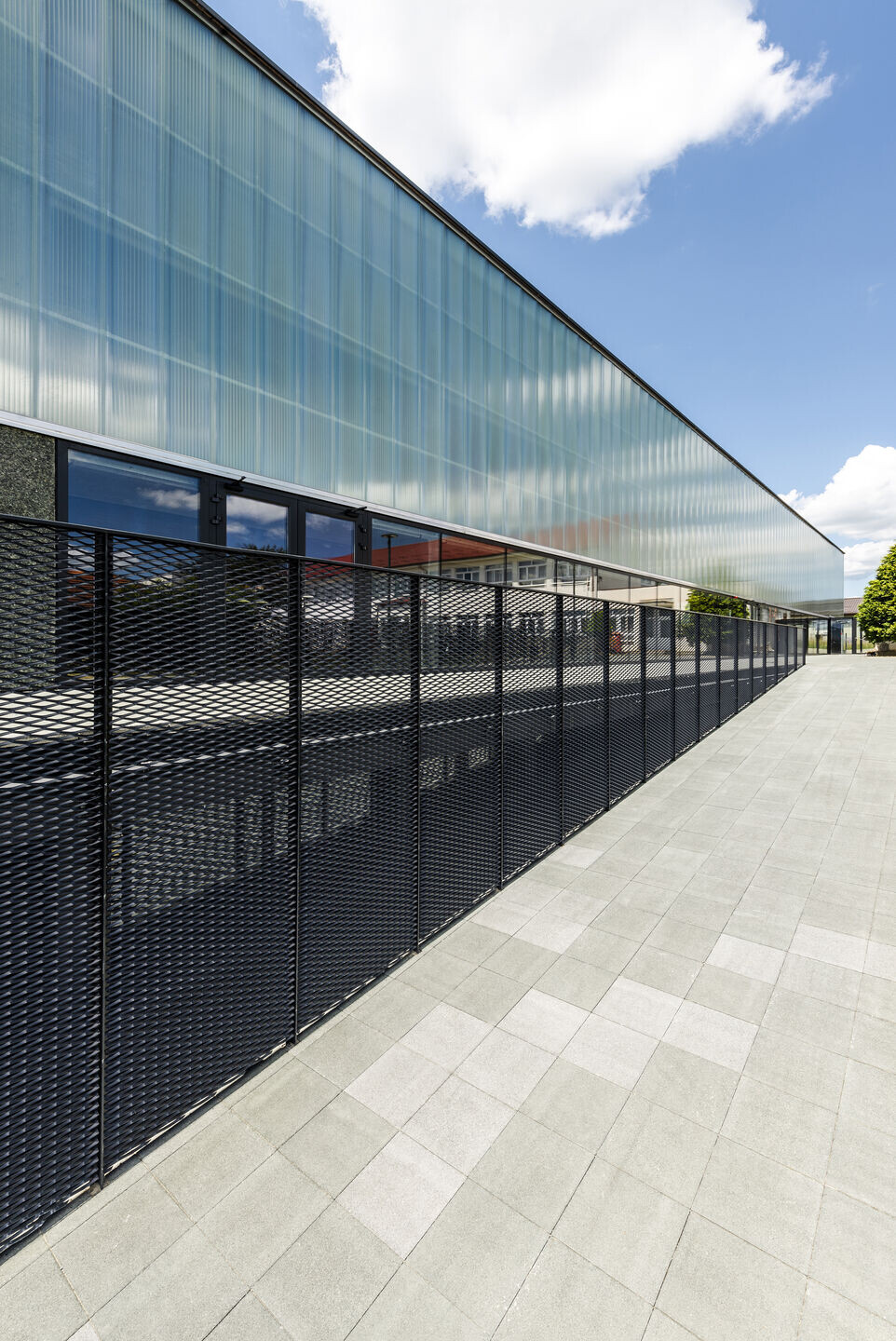
The sports hall project for Zlatar Bistrica had to face all these challenges. Zlatar Bistrica is a small town located in one of the few plains of otherwise hilly Hrvatsko Zagorje in northwest Croatia, a town with but a few distinct urban features, such as the school, church, and community health centre scattered along the two main roads, Vladimir Nazor and Zagorska. Withdrawn further away from the main roads, the school and the church do not define the street view leaving it mainly rural. The school complex is in symbiosis with its rural environment; its neat, relatively neutral modern architecture defines the access square on two sides, while the remaining two sides border with a typical rural property with outbuildings. This arrangement fits nicely with the school yard, which is used to grow plants and teach children about nature and agriculture.
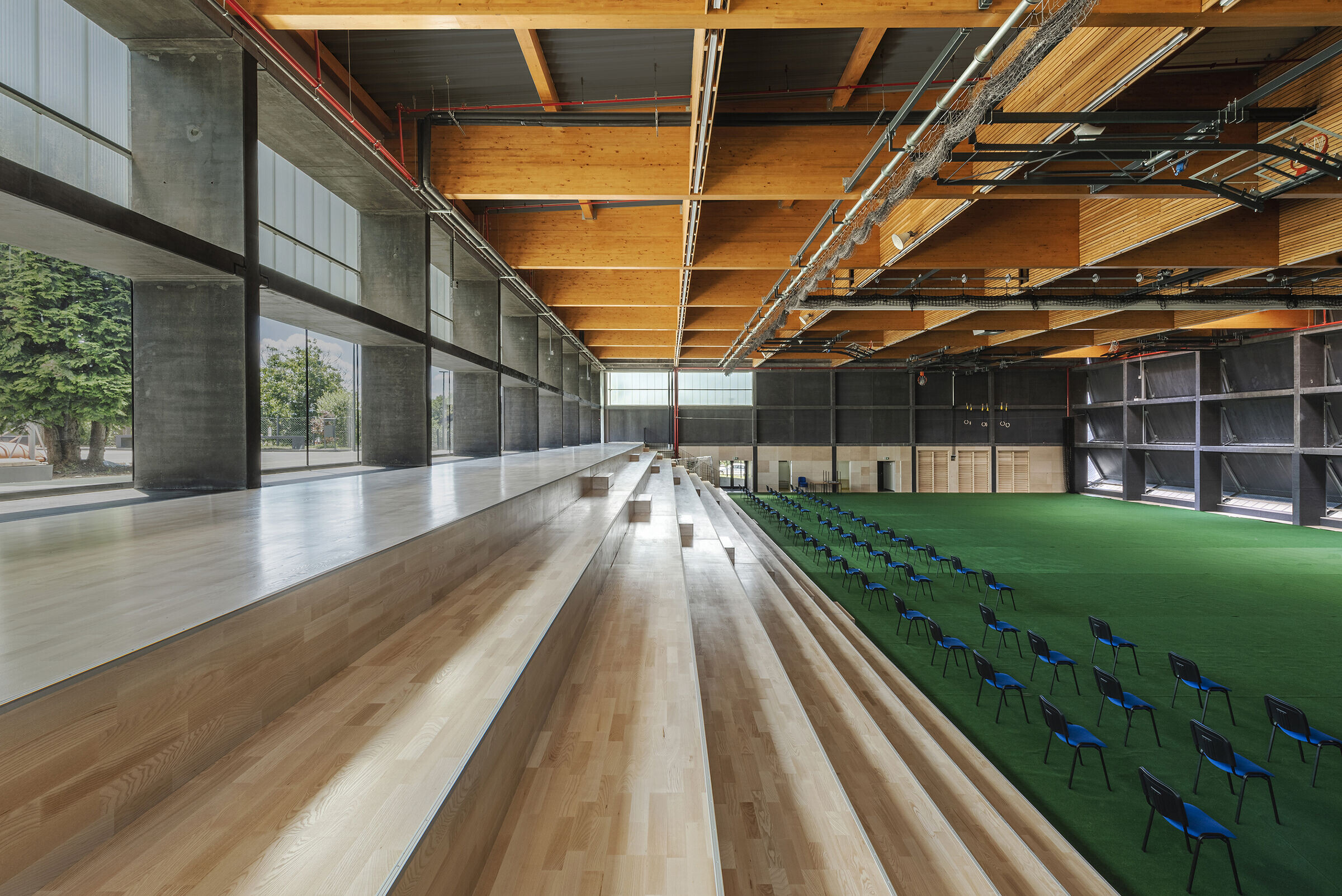
Micro-urban response to land configuration
The western perimeter of the school square used to border with a sports hall that had been destroyed by fire, and the new hall project inherited its former orientation as an important parameter to be integrated with the building's new external and internal configuration. The hall has been placed on a lot sloping toward the west and configured to respond to the given urban and topographic determinants.

The perimeter around the hall is designed to establish connection between the school square and the lower plateau with open court and school parking lot for the school bus and vehicles bringing children from neighbouring villages. From there runs the main pedestrian access configured as a system of a stairway and a ramp. The interior reflects this sloping exterior pedestrian configuration. The façade that opens to the school square with glazed ground level and entrance allows the public square space to enter the interior and then cascade down the grandstand staircase to the lower sporting level, which is why the square has a clear view of what happens in the hall and vice versa. The square and the hall interior complement each other and exchange views in an almost seamless and direct shift between what goes on in the hall and outside. The outer layer of the hall is made of translucent polycarbonate, which at night turns the entire volume of the building into a lantern illuminating the school square and the surrounding area.

Deconstruction of the conventional volume
This lantern motif points to the problem of shaping the volume of the hall. The author considered several variations that would be both pragmatic and innovative in form. Much attention has been given to incorporating customised prefab elements that have only recently been introduced to construction and tried out in Croatia. Instead of using generic prefab panels, the author has worked with the Beton Lučko company specialised for concrete prefabs to develop a unique type of panels with the outer and inner layer made of pigmented black concrete and thermal isolation in between. While their cross-section is standard, their design took some research into production technology. The way the panels are mounted is also innovative. The author decided to give up conventional design with completely walled lower section and light openings in the upper section and to replace it with horizontal panels placed at an angle from the vertical like shutters to let in diffuse light. The panels are mounted on a steel structure fixed to prefabricated concrete pillars, and their lower, gaping end is closed with polycarbonate. The lowest row of panels gapes at the greatest angle from the vertical, which gradually diminishes with each new row going upwards. Such a configuration provides enough diffuse light to the interior, prevents glare, and provides better protection from the western sun and heat in the warm season.

The exterior, in turn, has a dynamic, rhythmical texture thanks to the slanted panels. These panels are made of a dolomitic aggregate diabase of an original green hue mixed with a black pigment added in production, which is why the smooth "black" concrete is never entirely black. Additional hues and even colours are obtained with different slanting of the panel rows as they reflect the colour of the sky differently. On an average overcast noon these hues and colours span from lead grey to matte dark green, while on a clear sunset the colours can even become warm. At night, the western façade is distinguished by horizontal stripes of light emitting from the interior on the pavement running along the sports court.

Panels on the gable walls are not as polished as the west façade and yield a greenish texture of the aggregate diabase bearing reference to greenstone slates from the nearby Medvednica mountain, which used to be a popular local construction material, now completely exhausted. The matte colour palette is completed with black iron plates and sheets of which fences and screening window panels are made.

Interior as a well-coordinated system
Interior space and surfaces, including the ceiling, are configured to reflect the precise geometry of the bearing prefab elements. Load-bearing verticals and horizontal beams are made of concrete prefabs, also in black. They carry the grid-like structure of the roof made of laminated wood supports, whose light material contrasts the heavy concrete skeleton. Along the western roof area extend light domes that provide additional natural lighting. The author has given much attention to modular configuration of building and infrastructural elements, having neatly integrated artificial lighting and air conditioning and ventilation elements into the geometry of the whole.
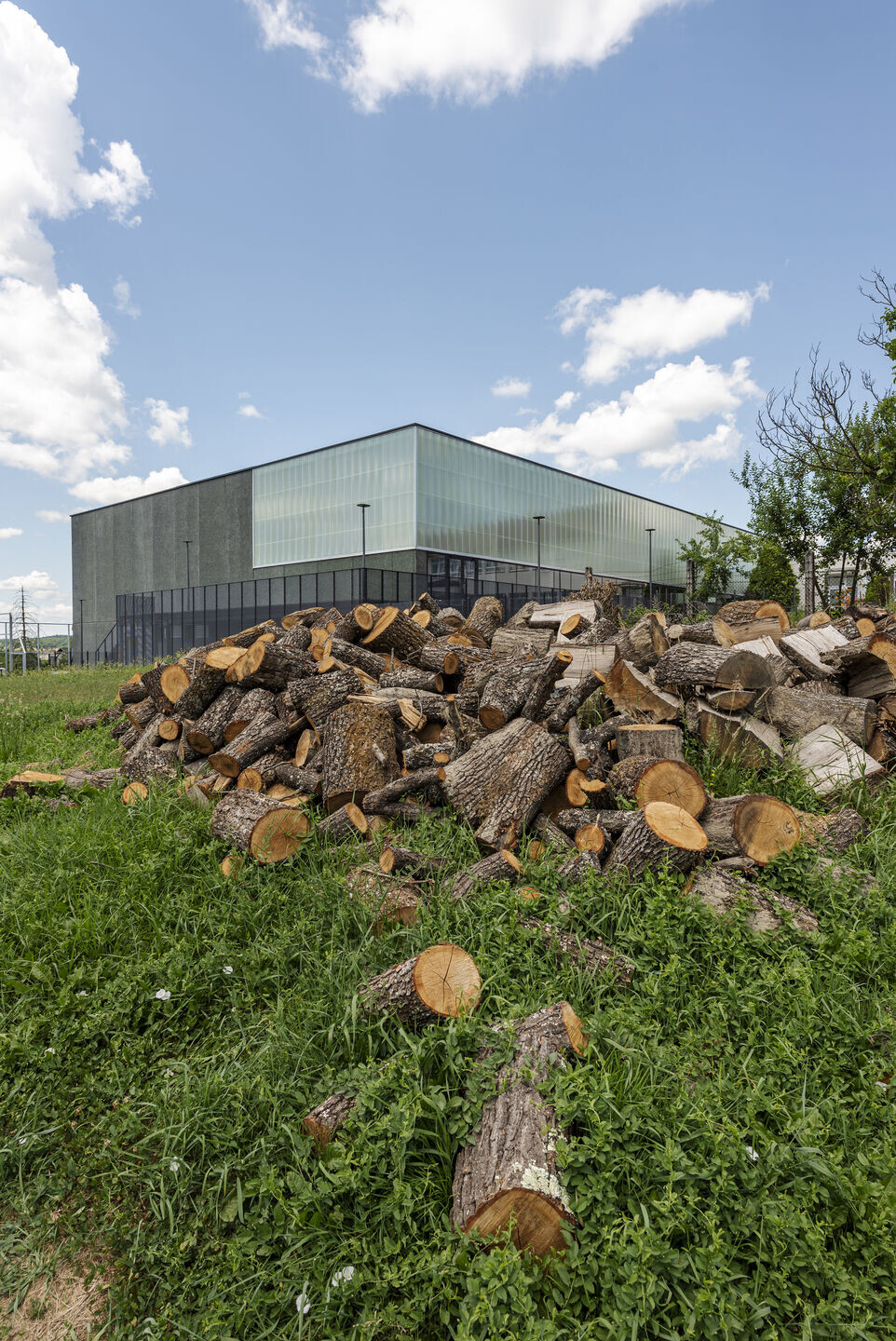
Unlike most grandstands done in recent times in Croatia, this one in Zlatar Bistrica is a fixed, wood-panelled cascade descending from the square and entrance on one side to the sports courts on the other. It gives an air of a dignified and representative public space comparable to monumental urban staircases that invite people to gather there and socialise. This concept of socialisation during leisure time is exactly what the author had in mind by insisting on spatial continuity. For him, this grandstand is a specific interior landscape that gives children and others the liberty to use it as creatively as they see fit.

Secondary facilities such as changing rooms, toilets, and corridors showcase some skilful design with the simplest of materials and equipment. They all share colour yellow that sparks the energy of sporting events. Toilets are visually playful and rather distinct as they combine black grout lines with yellow and white tiles, whereas elements such as lockers, benches, and partitions follow the same consistent modular configuration as the rest of the sports hall.
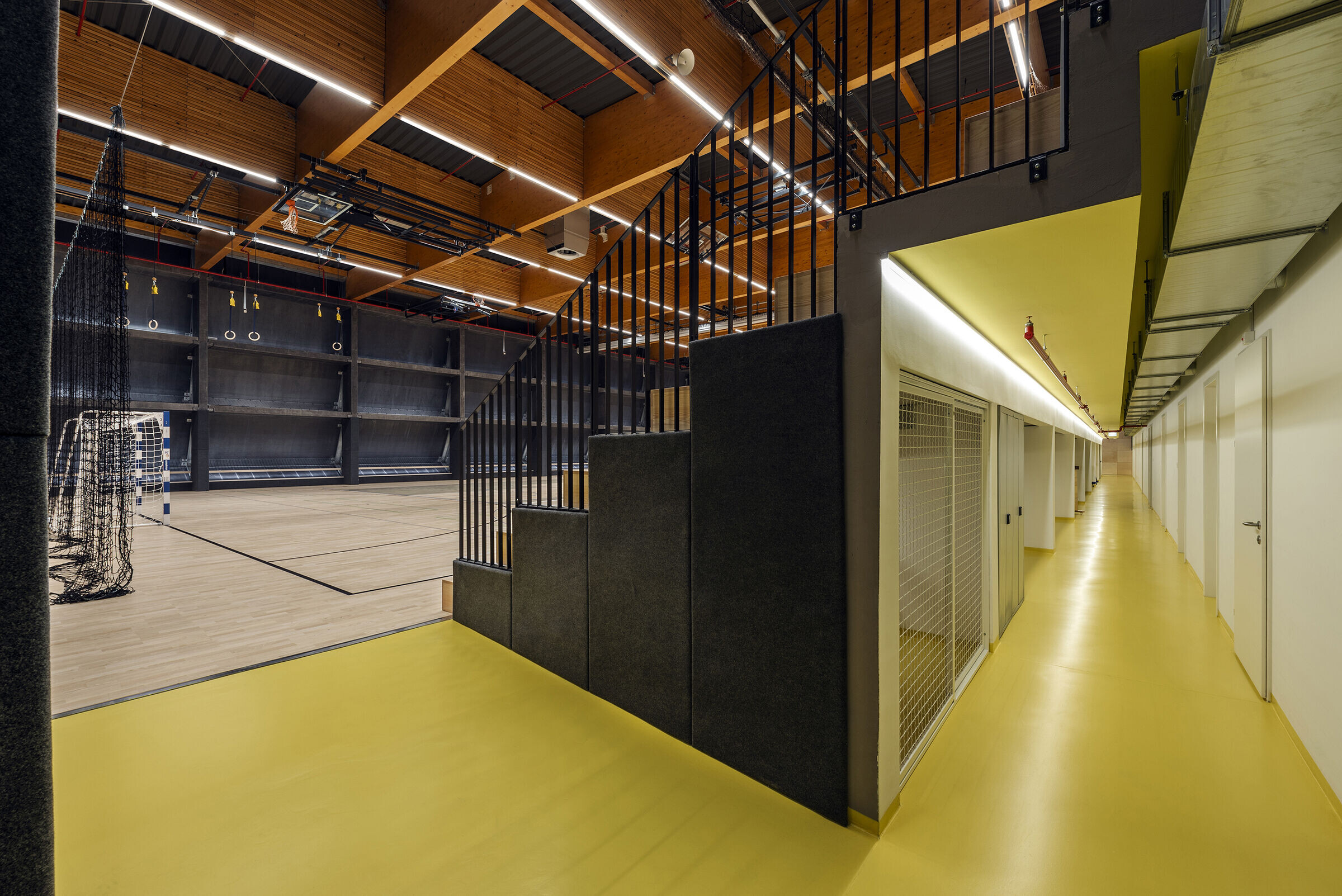
New architecture culture and empathic interpretation of everyday life
The Zlatar Bistrica sports hall showcases an ambitious design that imparts the sense of contemporary architectural culture to a small town. All aspects of design have been treated with equal attention, which is why everything that goes on inside and around – from big events involving the entire local community to intimate, informal gatherings – has been fitted into an appropriate architectural framework. Its clear urbanistic reasoning, the interesting, "deconstructed" form of the western façade and structural precision of the ensemble give distinct identity not only to the school complex but to the entire town. This project has succeeded in addressing and harmonising varying functions of such an important investment for the community, and the formal quality of the building reflects an empathic interpretation of everyday life.
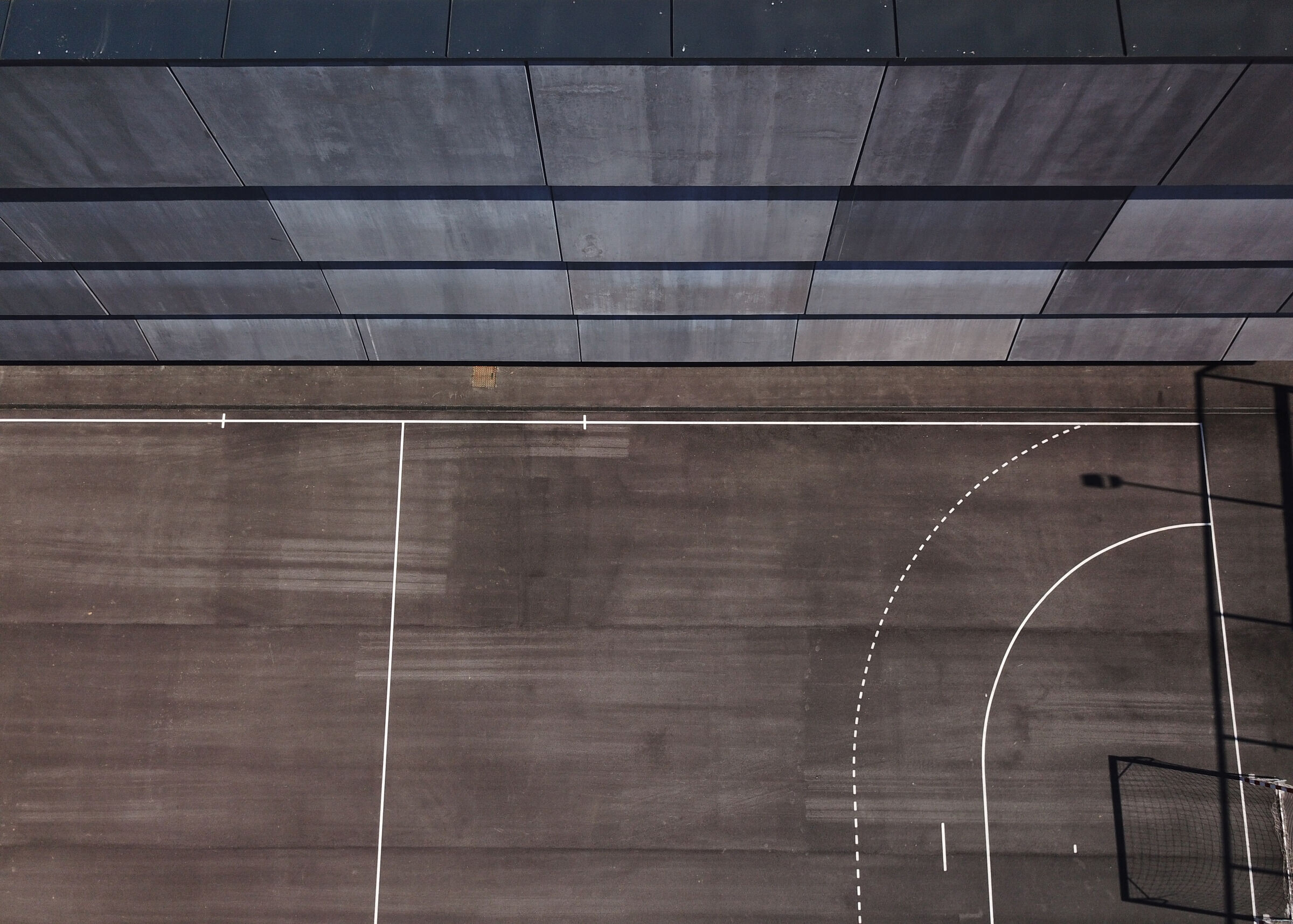
Team:
Architects: NOP Studio / Ivan Galić
Project design team: Rea Vidović, Robert Bodiš
Collaborators: Krešimir Tarnik (construction project), Mateo Biluš, (building phisics), Goran Tomek (mechanical design), Branimir Cindori (sprinkler project), Alen Farago (electrical project), Željko Mužević (fire protection and occupational safety)
Contractors: Zagorjegradnja d.o.o. (main contractor), Beton Lučko d.o.o. (contractor of prefabricated reinforced concrete elements), Drvene konstrukcije d.o.o. (wooden load-bearing structure)
Photography: Bosnić+Dorotić
Aerial Photography: Danijel Krznarić



























